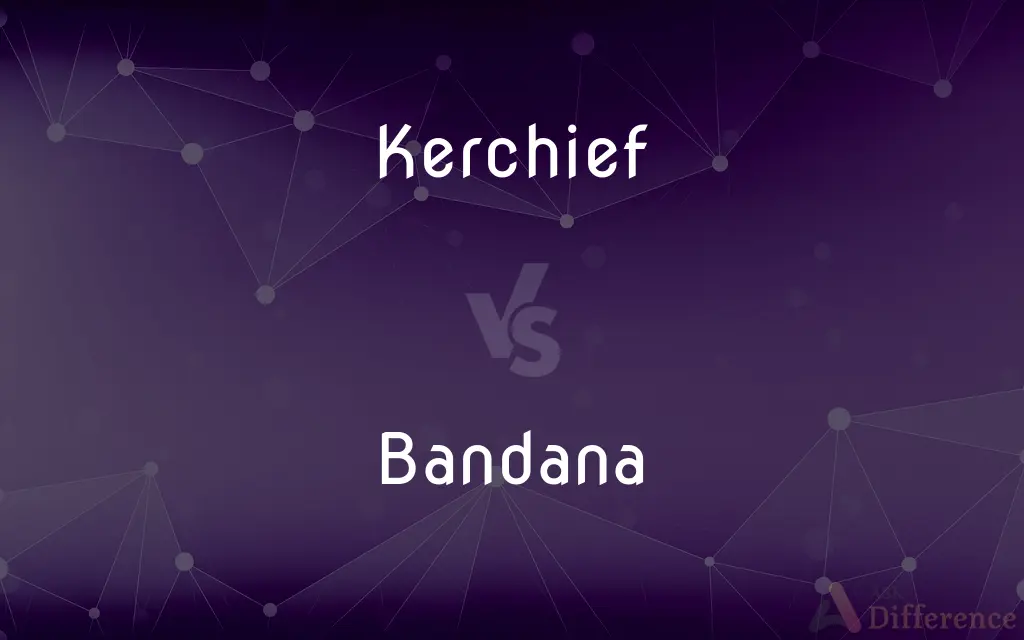Kerchief vs. Bandana — What's the Difference?
By Tayyaba Rehman & Urooj Arif — Updated on April 26, 2024
Kerchiefs are traditional square cloths worn around the neck or head for protection or fashion, while bandanas are typically colorful, patterned squares, often associated with rugged or casual wear.

Difference Between Kerchief and Bandana
Table of Contents
ADVERTISEMENT
Key Differences
A kerchief is usually made of a light, often delicate fabric such as silk or cotton, used primarily as an accessory or for personal hygiene. Whereas, a bandana is typically crafted from a sturdier, more durable cotton, featuring bold patterns like paisleys or geometric prints, aimed more at utility and style.
Kerchiefs often have a connotation of elegance and can be part of traditional costumes or formal wear. On the other hand, bandanas carry a more casual and sometimes rebellious aesthetic, making them popular in various subcultures and outdoor activities.
The use of a kerchief can be traced back to several cultures where it has practical and symbolic meanings, such as covering the head during religious observance. Meanwhile, bandanas originated in the early American West, becoming a staple among cowboys, miners, and railroad workers for protection against dust and sun.
In terms of versatility, kerchiefs are often used in a variety of ways including as neck scarves, head coverings, or decorative elements on purses. Bandanas, on the other hand, are more likely to be seen as headbands, neckerchiefs, or even makeshift masks, showcasing their rugged functionality.
While both items can serve similar purposes in fashion and function, kerchiefs tend to be associated with a more refined and understated look, suitable for formal attire or professional settings. Bandanas, contrastingly, are seen as accessories that add a bold, expressive touch to casual outfits.
ADVERTISEMENT
Comparison Chart
Material
Light fabrics like silk, cotton
Usually thicker cotton
Patterns
Plain or minimalistic
Bold, often paisley or geometric
Connotations
Elegance, formality
Casual, rugged
Common Uses
Fashion accessory, religious head cover
Practical use in outdoor activities, fashion statement
Cultural Origin
Various global traditions
American West
Compare with Definitions
Kerchief
A fashion accessory often seen in vintage styles.
He complemented his vintage suit with a classic kerchief.
Bandana
A square piece of cloth often worn on the head or neck.
He tied a bandana around his head before starting the hike.
Kerchief
Used for personal hygiene purposes, like wiping the face or hands.
She always carried a kerchief in her purse for sudden needs.
Bandana
Commonly associated with outdoor activities for protection against elements.
She pulled up her bandana to cover her face from the dust.
Kerchief
A traditional head covering in many cultures.
During the ceremony, all participants wore a white kerchief.
Bandana
Utilized as a functional tool, like signaling or carrying items.
He used his bandana to signal the end of the race.
Kerchief
A small piece of cloth worn around the neck or head for style or protection.
She wore a silk kerchief around her neck to add a pop of color to her outfit.
Bandana
Features bold patterns and colors, distinguishing it from more plain scarves.
The bright red bandana with paisley prints caught everyone's attention.
Kerchief
A kerchief (from the Old French couvrechief, "cover head"), also known as a bandana or bandanna, is a triangular or square piece of cloth tied around the head, face or neck for protective or decorative purposes. The popularity of head kerchiefs may vary by culture or religion, and may vary among Orthodox Jewish and Christian, Catholic, Amish, and Muslim people.
Bandana
A fashion statement popular in various subcultures.
The bandana became a symbol of rebellion in the punk scene.
Kerchief
A piece of fabric used to cover the head.
Bandana
A large handkerchief usually patterned and brightly colored.
Kerchief
A square scarf, often worn as a head covering.
Bandana
A large kerchief, usually colourful and used either as headgear or as a handkerchief, neckerchief, bikini, or sweatband.
Kerchief
A handkerchief.
Bandana
A style of calico printing, in which white or bright spots are produced upon cloth previously dyed a uniform red or dark colour, by discharging portions of the color by chemical means, while the rest of the cloth is under pressure.
Kerchief
(dated) A piece of cloth used to cover the head; a bandana.
Bandana
Large and brightly colored handkerchief; often used as a neckerchief
Kerchief
To cover with a kerchief.
Kerchief
A square of fine linen worn by women as a covering for the head; hence, anything similar in form or material, worn for ornament on other parts of the person; - mostly used in compounds; as, neckerchief; breastkerchief; and later, handkerchief.
He might put on a hat, a muffler, and a kerchief, and so escape.
Her black hair strained awayTo a scarlet kerchief caught beneath her chin.
Kerchief
A lady who wears a kerchief.
Kerchief
A square scarf that is folded into a triangle and worn over the head or about the neck
Kerchief
Part of uniform attire in certain professions.
The chef's kerchief was neatly tied around his head.
Common Curiosities
Are bandanas suitable for formal events?
Bandanas are typically more suited to casual settings due to their bold patterns and rugged connotations.
Can a kerchief be used for protection against the sun?
Yes, kerchiefs can be used for sun protection, although they are thinner and less effective compared to bandanas.
What is the most iconic pattern seen on bandanas?
The most iconic pattern on bandanas is the paisley design.
What is the primary material of a kerchief?
Kerchiefs are primarily made from light materials like silk or cotton.
How did bandanas become popular in American culture?
Bandanas became popular in American culture through their use by cowboys and outdoor workers as protection against environmental elements.
How can a bandana be styled for a modern urban look?
A bandana can be styled around the neck, as a headband, or tied on a bag for a modern urban look.
Are kerchiefs and bandanas seasonal accessories?
While they can be worn year-round, bandanas are particularly popular in warmer seasons due to their practical uses.
What are the practical uses of a bandana beyond fashion?
Beyond fashion, bandanas are used for protection, carrying items, and even as makeshift bandages.
How should a kerchief be washed to maintain its quality?
Kerchiefs, especially those made of silk, should be gently hand-washed or dry cleaned.
Can kerchiefs be part of a professional attire?
Yes, kerchiefs can be elegantly incorporated into professional attire.
Are there gender-specific styles for bandanas or kerchiefs?
Both bandanas and kerchiefs are versatile and unisex, though specific styles may vary by culture and personal preference.
Is it culturally appropriate to wear a kerchief or bandana in all settings?
Cultural appropriateness can vary, so it's best to understand the specific context and traditions of the setting.
What differentiates a kerchief from a typical scarf?
Kerchiefs are typically smaller and often square, while scarves can be longer and come in various shapes.
How do bandanas contribute to a rugged look?
The sturdy material and bold patterns of bandanas contribute to their rugged, adventurous look.
Share Your Discovery

Previous Comparison
Fish vs. Tadpole
Next Comparison
Lodging vs. BoardAuthor Spotlight
Written by
Tayyaba RehmanTayyaba Rehman is a distinguished writer, currently serving as a primary contributor to askdifference.com. As a researcher in semantics and etymology, Tayyaba's passion for the complexity of languages and their distinctions has found a perfect home on the platform. Tayyaba delves into the intricacies of language, distinguishing between commonly confused words and phrases, thereby providing clarity for readers worldwide.
Co-written by
Urooj ArifUrooj is a skilled content writer at Ask Difference, known for her exceptional ability to simplify complex topics into engaging and informative content. With a passion for research and a flair for clear, concise writing, she consistently delivers articles that resonate with our diverse audience.
















































